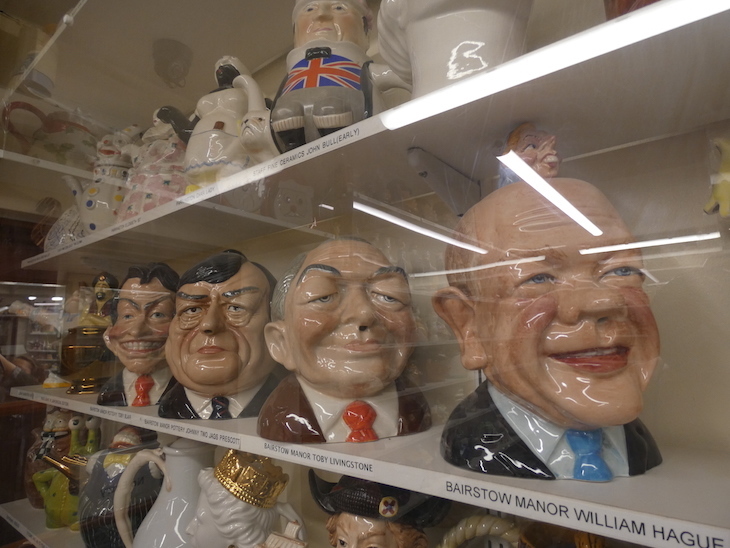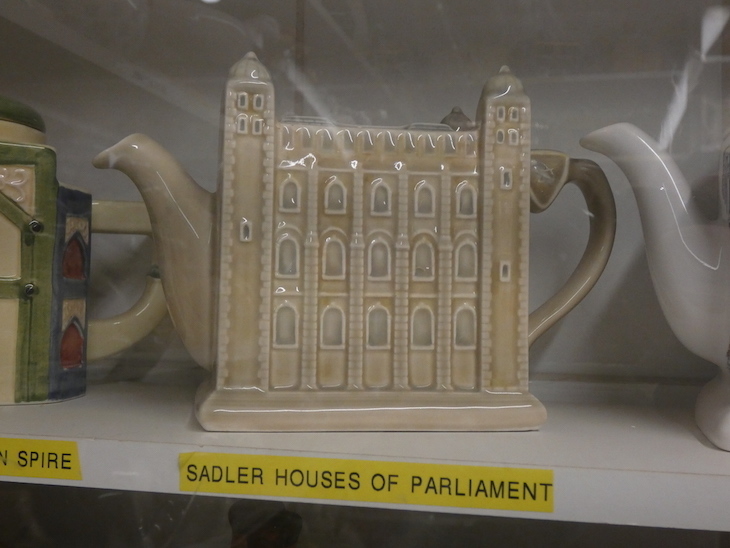
Call off the search, bring back the hounds — we've found the most British day out in England. A trip to a teapot museum.
The bucolically named Teapot Island is just that; an island dedicated to teapots. It's not big — you could walk a lap in about a minute — but it has the enviable claim of owning the world's largest teapot. That particular chai vessel is the first one you spot, situated in the garden which doubles up as the exterior of the cafe. It's actually a teapot wishing well, raising money for the Kent Air Ambulance Trust, and was once visited by the-then Prince Charles and Camilla.

Opening the door to the museum, which has more than 8,000 teapots, we barely spot the lady sitting behind the counter — she blends into the jampacked display wall. This isn't even the museum, just the shop (teapots from £7.99), so we duly pay our minimal entry fees and with no further ado head through the door to the museum.

At this point, you're probably imagining just a few novelty teapots shaped like country cottages and the like, similar to the ones your great aunt brought back from WI coach trips in the 1990s... in which case, you've underestimated Teapot Island by quite a stretch.

As the door closes behind us, we find ourselves in a narrow corridor, flanked on each side by floor-to-ceiling perspex cases, which contain those eponymous teapots. The lighting bounces off the glass in such a way that it's impossible to take in the scale of what you're looking at, and you'll have to do plenty of ducking and diving to see beyond the reflections.

That first corridor seems random, though it's a good introduction to what's to come. Ceramic representations of people, places, buildings, cartoon characters, TV shows and historic moments, all equipped with a handle and spout, sit side by side, in no discernible order. And yet, you get the feeling that it all makes perfect sense to someone somewhere, like walking through the corridors of a teapot collectors's mind.

Past the moon landing, Princess Diana (cheekily placed directly below Charles and Camilla), David Bowie, Marc Bolan, the Statue of Liberty, and Hilda and Stan Ogden from Coronation Street, things start to get a bit more organised.

Categories seem to be emerging — fruit-themed teapots here, animal-themed teapots there, plus flower-themed teapots, and last but not least, teapots which are just shaped like teapots. But having had your eyes opened to the various quirky options available, chances are you'll never be satisfied with a run-of-the-mill spherical teapot in your kitchen again.

Just when you're getting to grips with the curation, an M&Ms teapot pops up next to the Eiffel Tower, which in turn is next to a Halloween pumpkin (for who doesn't have a different teapot for every season?). Vans, scooters, desks, helicopters, sewing machines, handbags, baked goods and a bath are just some of the shapes on display. Tea served from a washing machine? A fireplace? An iron? Tick, tick, and tick.

We spot five Winston Churchills (plus a sprinkling of other former prime ministers, and two Bill Clintons), two Daleks, multiple Winnie the Pooh characters, three Laurel and Hardys, but surprisingly only one Elvis, suggesting that tea and teapots remains a predominantly British interest.

London is well represented with Tower Bridge, Big Ben, Tower of London, Harrods and 10 Downing Street all taking teapot form — and for those south of the river, a Trotters Independent Trading van. There's even a couple of tricks thrown in, intentionally we're sure, to keep pedants on their toes:


Our favourite teapot in the collection? It's a toss-up between the bath, complete with duck (pictured above), purely for the Things-We-Never-Expected-To-See factor, or the Queen's head with a Borrower-sized Beefeater climbing in her hair to form a handle.

The beauty of Teapot Island is that, unlike pretty much any other museum we've ever been in, the exhibits are presented without context or comment, save shelf labels giving the briefest of information. The refreshing lack of overwhelming reading means that you can really focus on doing what you came here to do; ogle teapots.

The only item with any further information is a metal teapot with a bullet hole in, accompanied by an account of the German bomb which exploded in a garden in Bexley in 1942, causing the damage, written by Geoff Hurst who donated the teapot (the Geoff Hurst? It's not clear).

Two celebrity teapots, signed by TV antiques experts David Dickinson and Eric Knowles respectively, are presented without such explanation.

Aside from all the teapots, look out for the flood level markers, one located at the museum entrance and one halfway through. This area of Yalding is susceptible to flooding in autumn and winter, and in being surrounded by water, Teapot Island is particularly at risk. The markers show the waist-level depths the water reached on Christmas Day 2013, which resulted in then-Prime Minister David Cameron being heckled on a local visit.

You could whizz around the whole museum in ten minutes, or if teapots really get your kettle whistling, you could pass hours examining each one in detail. For most people though, 30 minutes is probably sufficient time to spend in the museum, which is the size of an average bungalow. In fact, it probably was someone's bungalow until either the teapots took over, or the flood risk became too great, forcing them to relocate to the mainland.

As well as the museum, Teapot Island is a cafe, offering hot and cold drinks, snacks and meals to refuel on after your visit. There's a kids' play area to one side, and an ice cream kiosk which makes it a popular stop-off for cyclists and walkers. If the weather's on your side, take a walk along the footpath alongside the museum, and follow the River Medway.
Visiting Teapot Island

Teapot Island is situated at the meeting of the Rivers Medway and Teise in Yalding, near Maidstone in Kent. It's about a 20 minute walk (on a fairly busy country road) from Yalding station. It you're coming by car, there's field parking in the Lees Car Park and Picnic Area next door — there's a parking charge, which has to be paid (coins, card or contactless) at the barrier on entry. Make sure you have your payment ready, lest you cause a traffic jam all along the road and over the single lane bridge (we've seen it happen...).

Teapot Island is fairly isolated, except for The Boathouse pub next door. The village of Yalding is about a 20 minute walk away. It's a beautiful village with many historic cottages, a few quirks, plus The Village Tearooms and The Walnut Tree pub, but it won't take you long to explore it all. Take a look at these other day trips in Kent for other things to do nearby.
Teapot Island, Hampstead Lane, Yalding, Maidstone, Kent, ME18 6HG. Entry to museum is £3 per adult.




